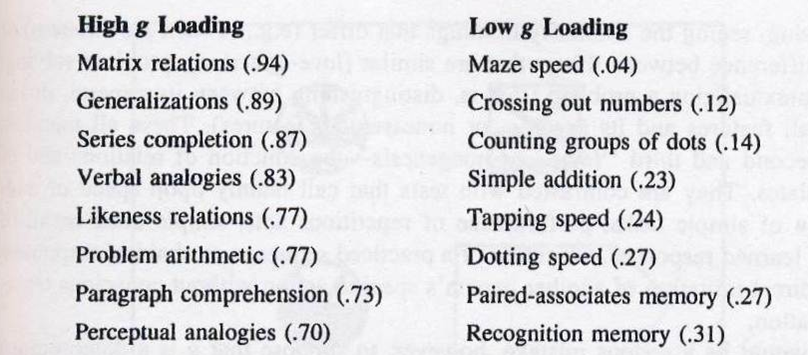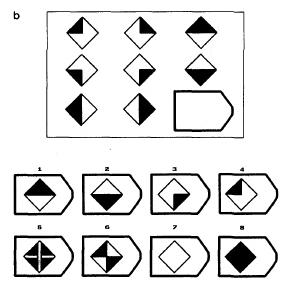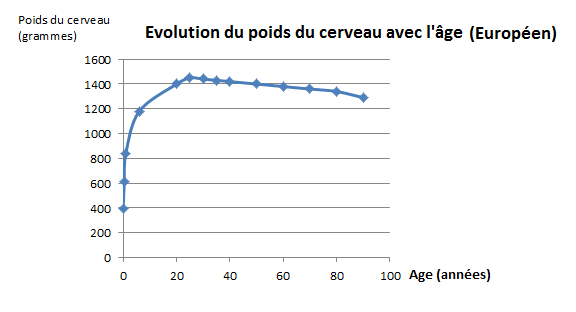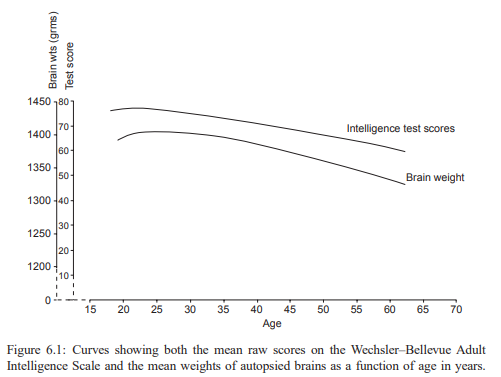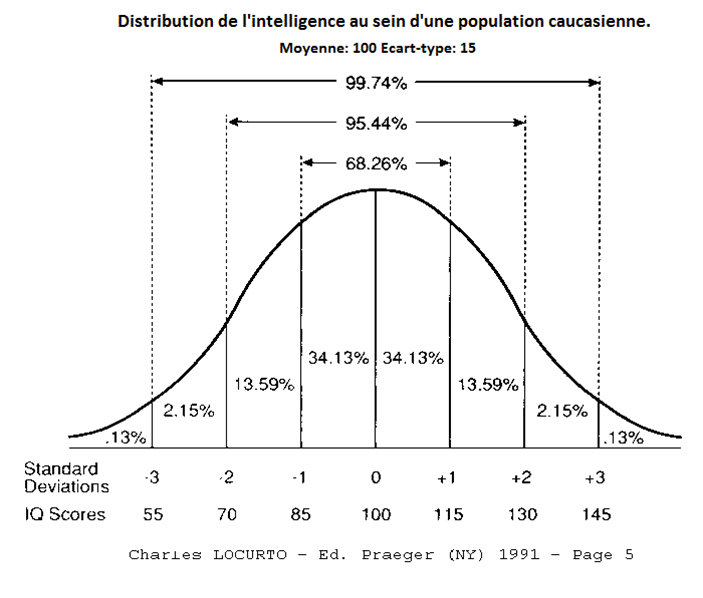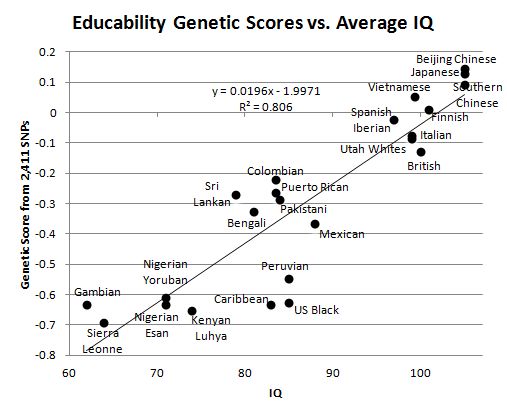FAQ (Frequently Asked Questions) on Intelligence
> What Is Intelligence?
> Can We Measure Intelligence?
> Different Types of Intelligence?
> What does IQ mean?
> Each Population Its Intelligence?
> What Is the Impact of Racial Differences in Intelligence on Global Geopolitics?
> What Is the g Factor?
> What Does “Indifference to Indicators” Mean?
> What Are the Average g in the Animal World, Including Homo Sapiens?
> Is IQ in your genes?
What’s Intelligence?
To discuss an issue meaningfully, it must first be clearly defined.
Qualitatively, most people perceive intelligence as a very general ability generated by the brain.
But is there a way to quantify and rank this ability?
One common criticism of IQ is that intelligence cannot be measured or ordered in a meaningful hierarchy.
How valid is this criticism?
Can We Measure Intelligence?
Intelligence is a biological, physiological, and organic characteristic—just like height.
Modern neuroscience has largely abandoned Cartesian dualism, which separates mind and body. Instead, it embraces a monistic view, where the mind is seen as inseparable from the brain. This perspective echoes the famous words of 18th-century French physician Pierre Jean Georges Cabanis:
“The brain secretes thought as the liver secretes bile.”
In this view, the mind is not an abstract entity but a direct product of the brain’s activity. Intelligence, as a biological trait, can therefore be measured and ranked. The hierarchy of intelligence can be illustrated with the following examples:
-
Great apes, whose brains show higher central nervous system efficiency than those of dogs, have an average mental age of 2–3 years and an estimated average IQ of around 22.
-
Dogs are typically estimated to have an average IQ of 12.
-
A 5-year-old child, with an IQ of around 35, is more intelligent than a great ape.
-
A 10-year-old child generally has an IQ of 70, showing a higher level of cognitive ability than a 5-year-old.
-
An average adult, with an IQ of 100, surpasses the intelligence of a 10-year-old child.
But can we establish a finer hierarchy—one that goes beyond broad comparisons, such as between a child and an adult—and instead distinguishes between two European adults, for example?
To quantify intelligence meaningfully, we must first understand exactly what we are trying to quantify…
Different Types of Intelligence?
If there were truly different, unrelated types of intelligence, it would imply that a person who is highly intelligent in one area might be completely lacking in another.
In that case, there would be no reliable way to quantify or rank intelligence overall.
However, research has shown that:
-
All cognitive abilities—even highly different ones—are positively intercorrelated.
-
Individuals who perform well in one cognitive domain tend to perform well in others.
-
This led to the discovery of a common underlying factor, known as g, or general intelligence.
-
IQ is designed to measure the general intelligence factor (g).
-
As a result, measuring a few key aptitudes is sufficient to estimate someone’s general intelligence, because they all reflect g to some extent.
Figure 2: General Intelligence (g) and Its Correlations
You can divide intelligence into as many categories as you like—spatial intelligence, verbal intelligence, mathematical intelligence, social intelligence, musical intelligence, and so on. You could even label them abstractly as I₁, I₂, I₃, I₄, I₅, I₆, I₇…
But the fact remains:
A person gifted in one domain is statistically likely to be gifted in others,
while a person with low ability in one domain is likely to show low ability across the board.
This phenomenon is the foundation of concepts like mental retardation or intellectual disability—conditions that would make no sense if general intelligence did not exist.
The division of intelligence into multiple types (literary, mathematical, artistic, social, musical, economic, etc.) is largely a cultural construct, rather than a concept rooted in biology or neuroscience.
From a biological perspective, **human intelligence is best understood as a general trait with a strong single component—**measured by the general intelligence factor (g).
As psychologist Arthur Jensen put it:
“One of the most remarkable discoveries of all psychology is that scores on all tests of each variety of mental ability are positively intercorrelated for any representative sample of the general population.”
Or, as other researchers have phrased it:
-
“g is to psychology what carbon is to chemistry.” – Chris Brand
-
“IQ is to sociology what gravity is to physics.” – Richard Lynn
-
“IQ is a fundamental part of a society. We must stop the dysgenic trend in America.” – William Shockley, Nobel Prize in Physics, inventor of the transistor
In fact, all cognitive activities—even the simplest ones—show some degree of saturation in g, meaning they correlate with general intelligence. This is true for activities processed through the central nervous system, including:
-
Logical reasoning
-
Spatial visualization
-
Memory
-
Musical ability
-
Language processing
-
Vocabulary acquisition
-
Basic cognitive tasks
Surprisingly, even low-level sensory tasks show a measurable correlation with g:
-
Auditory discrimination – High-IQ individuals can detect smaller differences between sound frequencies.
-
Visual color perception – Those with higher intelligence can distinguish finer variations in hue.
-
Simple reaction time – Faster and more consistent responses are linked to higher IQ scores.
In short, all cognitive activities have a certain degree of correlation with general intelligence (also called g loading)—
similar to how all programs on a computer rely on the processor, though some demand more power than others.
Figure 3: Different Cognitive Activities and Their ‘g Loading’ (Correlation with General Intelligence)
From The g factor, 1998, A. Jensen
All mental activities provide some estimate of general intelligence (g), but not all are equally accurate.
Take, for example, a simple arithmetic task—such as basic addition. The result of such a test offers only a weak estimate of g, with a g loading of just 0.23.
In contrast, Raven’s Progressive Matrices—a non-verbal test focused on pattern recognition and abstract reasoning—has a very high g loading of 0.94. This means that performing well on Raven’s Matrices is strongly predictive of high cognitive ability in other areas (abstraction, logical reasoning, and reflection), because it taps directly into general intelligence.
To illustrate:
If you want to test the speed of a computer, you don’t use a lightweight program—because even a weak computer will run it effortlessly, and the result won’t reveal much.
Instead, you run a demanding application to see how the system performs under pressure. That’s how you measure true processing power.
Likewise, intelligence tests with a high g loading—like Raven’s Matrices—serve as cognitive stress tests, providing a more accurate picture of a person’s general intellectual potential.
Raven’s Progressive Matrices are among the most effective tools for measuring general intelligence, with a g loading of 0.94. This makes them one of the best estimators of general intelligence (g).
Taking an IQ test is essentially completing a series of cognitive tasks that are strong estimators of g—much like running high-demand software on a computer to evaluate its processing power. Just as lightweight programs won’t reveal much about a computer’s speed, simple mental tasks won’t offer an accurate picture of someone’s intelligence. But complex tasks with high g loading will.
The validity of IQ is further supported by its strong predictive power for a wide range of social outcomes. For example:
-
A child’s IQ score is a robust predictor of future socioeconomic status,
-
It also correlates strongly with educational attainment,
-
It also predicts numerous other life outcomes, such as job performance and health.
IQ is also backed by biological correlations, including:
-
Brain volume: Higher IQ is moderately correlated with larger brain size (correlation ≈ 0.35),
-
Nerve conduction velocity: Individuals with higher IQs tend to have faster neural processing.
-
And many other physiological markers linked to central nervous system efficiency.
For a deeper exploration of these links, see the section:
“Validity of IQ: Biological and Social Correlates of Intelligence.”
General intelligence (g) tends to increase throughout childhood, alongside the natural growth of cranial capacity, and reaches its peak around age 25. From about age 30, it gradually begins to decline, and this decline accelerates more noticeably after the age of 80.
Evolution of brain weight and intelligence with age (below)
Intelligence increases throughout childhood and adolescence, reaching its peak around the age of 25.
After this point, it begins a slow and gradual decline, which becomes more noticeable with advanced age.
Even the most basic cognitive processes—such as simple reaction time or inspection time—follow a similar trajectory. These fundamental functions reflect the physiological efficiency of the brain, which also peaks around age 25.
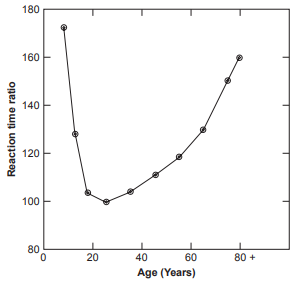
Reaction Time at Different Ages
The speed at which the brain processes information increases steadily with age, peaking around 25 years old (see graphs below).
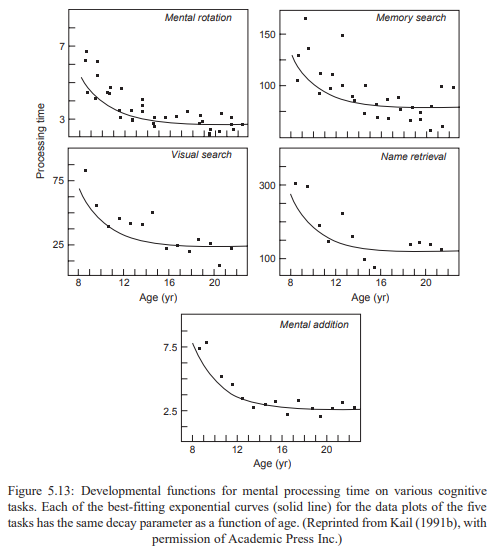
IQ follows a bell-shaped distribution, also known as a Gaussian or normal curve.
This means that most individuals have an IQ close to the average of 100 (which corresponds to the average intelligence of the European population), while fewer and fewer people are found as we move further from the mean, in either direction.
A helpful comparison is human height:
Many adult men are around 1.75 meters tall, while very few are either much shorter or over 1.95 meters. The same principle applies to intelligence.
This type of distribution allows us to precisely estimate the proportion of individuals who exceed (or fall below) a certain IQ level.
For example, we know that only about 2% of the European population has an IQ above 130.
IQ remains remarkably stable throughout life.
Studies have shown that the correlation between IQ measured at age 11 and the same individual’s IQ at age 80 is approximately 0.72—a strong and significant relationship.
(Deary, 2004; Hailer, 2016)
This stability highlights that general intelligence (g) is a long-term trait, not merely a temporary performance or a product of short-term factors.
What does IQ mean?
| IQ / g Factor | Potential Activities | Intelligence Level | % of European Population (≥ IQ) | Average Cranial Capacity |
|---|---|---|---|---|
| 200 | Polymaths (e.g. Pascal, Galton, Newton, Marilyn vos Savant) | Highest measured intelligence in humans | Extremely rare | – |
| 175 | Great philosophers or writers (Cox, 1926) | – | 1 in 4 million | – |
| 165 | Estimated average of great composers (Cox, 1926) | – | – | – |
| 158 | Measured average IQ of Nobel Prize winners in science | – | 1 in 31,000 | 1640 cc |
| 145 | – | Highly Gifted | 0.14% | – |
| 135 | – | – | 1% | – |
| 130 | Physicists, surgeons, civil engineers, university professors | Very Superior Intelligence (Mensa level) | 3% | 1494 cc |
| 125 | Average IQ of doctors and postdoctoral researchers | Intellectual precocity | 5% | – |
| 120 | Average IQ of pharmacists | – | 9% | – |
| 115 | Average science graduates | Superior Intelligence | 16% | 1432 cc |
| 110 | Average among university students | – | 25% | – |
| 105 | – | – | 37% | – |
| 100 | General European average | Normal Intelligence | 50% | 1369 cc |
| 95 | Car dispatchers, clerical roles | – | 63% | – |
| 90 | – | – | 75% | – |
| 85 | Learning difficulties, repeated academic failure, suited to manual work | Borderline Intellectual Functioning | 84% | 1307 cc |
| 80 | Difficulty maintaining stable employment | – | 91% | – |
| 75 | – | – | – | – |
| 70 | DSM-5 threshold for intellectual disability | Beginning of Intellectual Disability | 98% | 1244 cc |
| 50–70 | Slow learning, often in special education, limited creativity or curiosity | Mild Intellectual Disability | – | – |
| 35–50 | Incomplete language, no autonomy, limited school learning | Moderate Intellectual Disability | – | – |
| 20–35 | Almost no language, no autonomy | Severe Intellectual Disability | – | – |
| <20 | Requires constant care, nonverbal communication | Profound Intellectual Disability | – | – |
Corroborating Montesquieu’s thesis in his Theory of Climates, modern findings in scientific psychology and evolutionary biology have strongly supported the idea that many human behaviors and psychological traits—including intelligence—have a significant innate, genetic basis.
(See: “Intelligence Is Essentially Genetic”, “Cause of Racial Differences”, and “Evolution of Intellectual Differences”.)
Climate, particularly during major events such as the Ice Age, is believed to have played a crucial role in shaping the development of population-level cognitive traits over evolutionary timescales.
General intelligence (g), accurately assessed through IQ, has proven to be one of the most reliable and predictive measures of both individual and group outcomes. Its strong correlations with biological traits and its predictive power in areas such as education, occupation, and social behavior make IQ an indispensable tool in understanding human potential.
Does Each Population Have Its Own Intelligence?
It can be helpful to broaden the concept of intelligence by considering the idea of adaptive intelligence. Every species that exists on Earth today has, by definition, shown an ability to adapt to its environment and survive through natural selection. In that sense, every living organism—from bacteria to mammals—possesses some form of adaptive intelligence.
For example:
-
Bacteria can survive extreme temperature changes and reproduce rapidly.
-
Chameleons exhibit sophisticated camouflage.
-
Hedgehogs are protected by spines.
-
Cheetahs are adapted for exceptional speed.
All of these traits reflect biological adaptations that enhance a species’ ability to survive and reproduce. These forms of survival-related problem-solving can be referred to as adaptive intelligence—a broad, evolutionary-based definition.
However, this is not the kind of intelligence measured by IQ tests. IQ focuses on cognitive intelligence, which involves reasoning, abstraction, memory, language, and problem-solving—capacities linked to the brain’s neural architecture and performance.
Cognitive intelligence can be considered a subset of adaptive intelligence, specifically one that is brain-based and measurable. It is this form of intelligence that is hierarchical—some species, and some individuals, demonstrably outperform others on tasks involving logic, language, memory, and reasoning.
To illustrate:
Do you consider a cat or dog as intelligent as a human being?
Most people would say no—because they’re referring to cognitive intelligence, not general adaptability.
If, however, you ask: “Do cats or dogs have the same adaptive intelligence as humans?”, the answer is more complex. Both species continue to exist and thrive, suggesting a form of successful adaptation.
But when it comes to cognitive abilities, humans clearly surpass other species.
Cognitive Intelligence in Human Populations
This website focuses on cognitive intelligence—the type that can be quantified and compared across individuals and populations, as illustrated in Figure 1.
Research in psychometrics and evolutionary psychology has found variations in average IQ scores among different human populations. The data below are drawn from published meta-analyses and are subject to ongoing debate in the scientific community:
| Population Group | Estimated Average IQ |
|---|---|
| Ashkenazi Jews | 110 |
| East Asians | 105 |
| Europeans | 100 |
| Southeast Asians | 92 |
| Inuit | 91 |
| Caucasian-African mixed heritage | 81–90 |
| Native Americans | 86 |
| North Africans & South Asians | 84–88 |
| Sub-Saharan Africans | 71–80 |
| Australian Aborigines | 62 |
| Bushmen (San people) | 54 |
These differences have been interpreted by some researchers as partially genetic in origin, suggesting that climate and environmental pressures—particularly in colder regions—may have exerted greater selective pressure on problem-solving and abstract reasoning abilities over generations.
Such hypotheses propose that:
-
Populations evolving in harsh, cold climates may have developed greater cognitive demands for planning, tool use, and long-term survival, leading to higher frequencies of alleles associated with intelligence.
-
These genetic variants are believed to influence brain size, neural efficiency, and other neurophysiological processes that underlie cognitive performance.
Each population has different assets, which are called culture. Take a computer and compare it to a human brain. The power of the computer, that is, its central processor, is the electronic counterpart of biological human intelligence; it is, in a way, the intelligence of the computer. On this computer, you can have different operating systems and different other programs, it is acquired, it is somehow the culture of the computer, which he assimilates from the outside.
It is at the level of this central processor that the different races of homo sapiens vary. It is not a “cultural bias”. Australian aborigines show the lowest IQ, they also have the smallest average cranial capacity and a slower nerve conduction velocity. East Asians have the highest average IQ, the largest average cranial capacity, the fastest nerve conduction velocity, and the highest allele frequencies for traits associated with high intelligence. On the other hand, the IQ shows an equivalent predictive power for all races. In terms of identical IQ, the average salary of an African American and a European is, for example, the same. This is because on average the different races do not have the same intelligence that we find social disparities in societies, this was demonstrated for the United States by Muray and Hernstein (professor of sociology at Harvard) in “The Bell Curve”, then this has been demonstrated for all the multi-ethnic countries of the planet in “The Global Bell Curve”, 2009, Lynn. For a summary, see “Intellectual Hierarchy Around the World.”
| Computer | Brain | |
| Information processing | Hardware | Intelligence measured by g (central nervous system efficiency) |
| External acquisitions by: | Softwares | Various learning (speech, numbers, studies …) |
What is the impact of racial differences in intelligence on global geopolitics?
It is central and directly causal. For example, 75% of the differences in average wages per capita can be explained by the differences in IQ between nations.
See the summary table “From Genes to Civilization.”
See also “IQ by country and economy”
What Is the g Factor?
As seen previously, the factor g is, in fact, almost a synonym for IQ, but pedagogy involves repetition, and it is necessary to understand what factor g is. The factor g (g for general intelligence) is a biological, organic, person-to-person characteristic underlying all the processes that pass through the central nervous system.
It was discovered by Charles Spearman, who realized that all mental processes were inter-correlated so that someone who performed well in one area tended to perform better everywhere else, while a mentally deficient person, for example had tended to be weak in all cognitive processes. What had astonished Spearman at the time was that the finesse of sound frequency recognition (A test where sounds of different frequencies are heard and the highest sound is heard. Increasingly, the hierarchy obtained by this auditory test was identical to that obtained by a classical IQ test: in other words, the fineness of the auditory spectrum seemed to correlate with the factor g and the people with a high g factor (a high IQ) have on average a finer auditory and visual spectrum The factor g is in a way a measure of the power and complexity of the central nervous system.
The phenomenon of positive intercorrelations in the set of mental abilities (called “positive manifold”) has been described as “probably the most reproduced result of all psychology” (Deary, 2000).
The factor g is measured in IQ units and is usually extracted from a conventional test battery.
What does “Indifference of Indicators” mean?
Take the example of a computer. Imagine that you have before you ten different computer cubicle machines and you do not know the power. To extrapolate the speed of the processor, you will run computer programs and try to distinguish if these programs run more or less quickly; this is exactly what is done to compare competing machines. Any program or almost will be good to make a comparison because all programs are dependent on the central processor. After having tested only a limited number of programs, it will be possible to correctly estimate the speed of the processors of the ten machines and to make a correct hierarchy of their powers.
It is the same for the factor g, which is ubiquitous in the processes passing through the central nervous system: cognitive tasks, visual finesse (ability to distinguish closer color tones), auditory, and speed of processing information. So that the type of test is not important to identify a person’s g-factor, because all cognitive tests of any kind involve the factor g.
Since all cognitive results are intercorrelated, it suffices to do a few types of tests in order to extract, by factor analysis, the g-factor of an individual.
The factor g extracted from any type of test bank will always be the same, within the limits of the measurement error.
All types of tests, whatever they are, contain a certain saturation in g. As a result, a composite score of different tests will have more and more saturation in g, because the composition in g accumulates in the composite score while the non-correlated elements in g cancel each other out.
The factors g extracted by different test batteries show correlations between 0.95 to 1. Basically, it is the same entity that is measured, underlying all the processes passing through the central nervous system.
What are the average g in the animal world, including homo sapiens?
Ashkenazi Jews: 110 (2/3 with an IQ between 93 and 127, ie, a standard deviation of 17)
East Asians or Mongoloid: 105 (2/3 between 90 and 120)
Europeans or Caucasians: 100 (2/3 with an IQ between 85 and 115)
Southeast Asians: 92
Inuit: 91
Average homo sapiens: 90
Native Americans: 87
North African and South Asian: 84-88 (2/3 with an IQ between 71 and 97)
12-year-old European: 75
Sub-Saharan Africans: 67-80 (2/3 with an IQ between 56 and 78 for the natives of Africa)
Aborigines of Australia: 62
Bushmen: 54
European of 8 years: 50
Great apes: 25 (some gifted monkeys reach g factors of 80 or even 90)
Border collars: 15 (there too, there is an internal variation!)
To go further, Validity of IQ: Biological and Social IQ correlations.
Is IQ Hereditary?
Yes, essentially. But the term hereditary means ‘influenced by genetic factors’ and not ‘identical to parents’! You may very well have blue eyes while both of your parents have brown eyes. The intellectual variations between individuals and between ethnic groups are mainly of genetic origin. They are consequent to variations in the frequencies of alleles for high and low intelligence. These alleles are being discovered little by little.
For a more detailed argument, see Intelligence Is Highly Genetic.
References (not exhaustive)
Deary, I. J. (2010). The neuroscience of human intelligence differences. Nature Reviews Neuroscience, 11(3), 201–211. https://doi.org/10.1038/nrn2793
Jensen, A. R. (1998). The g factor: The science of mental ability. Westport, CT: Praeger Publishers.
Jensen, A. R., Langan, C., & LoSasso, G. (2002). Discussion on genius and intelligence: Mega Foundation interview with Arthur Jensen. Mega Foundation. Retrieved from [Insert URL if available]
Larivée, S., Goulet, D., & Lavoie, L. (2009). Le quotient intellectuel, ses déterminants et son avenir. Montreal, Canada: Éditions Multimondes.
Lynn, R. (2015). Race differences in intelligence: An evolutionary analysis (2nd ed.). Augusta, GA: Washington Summit Publishers. (Original work published 2006)



